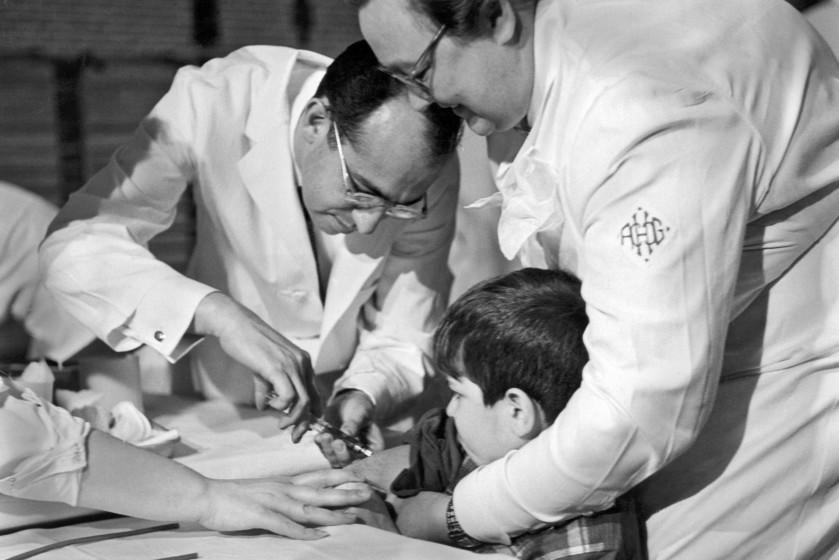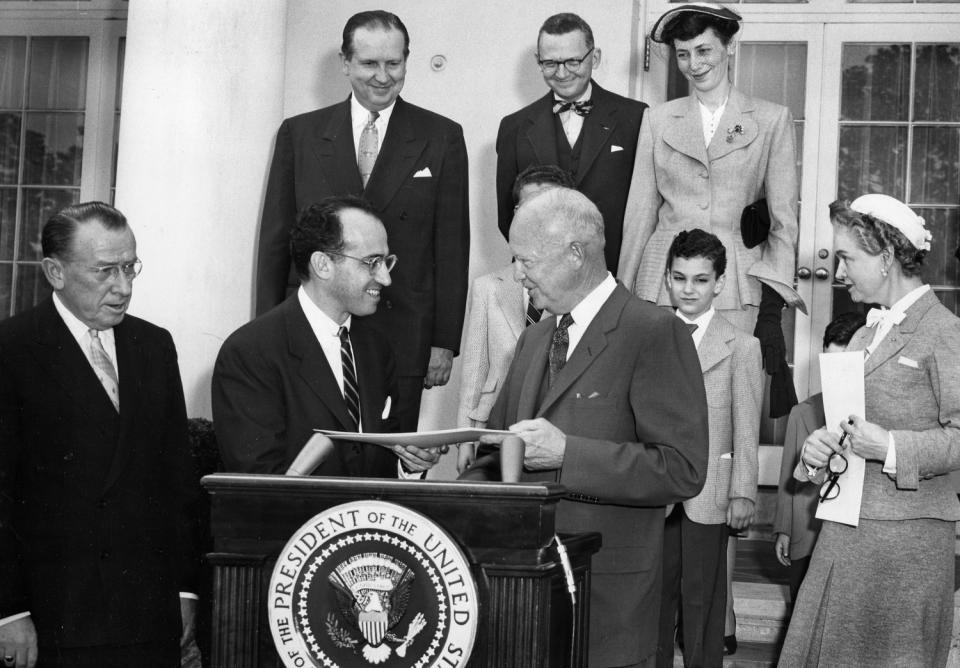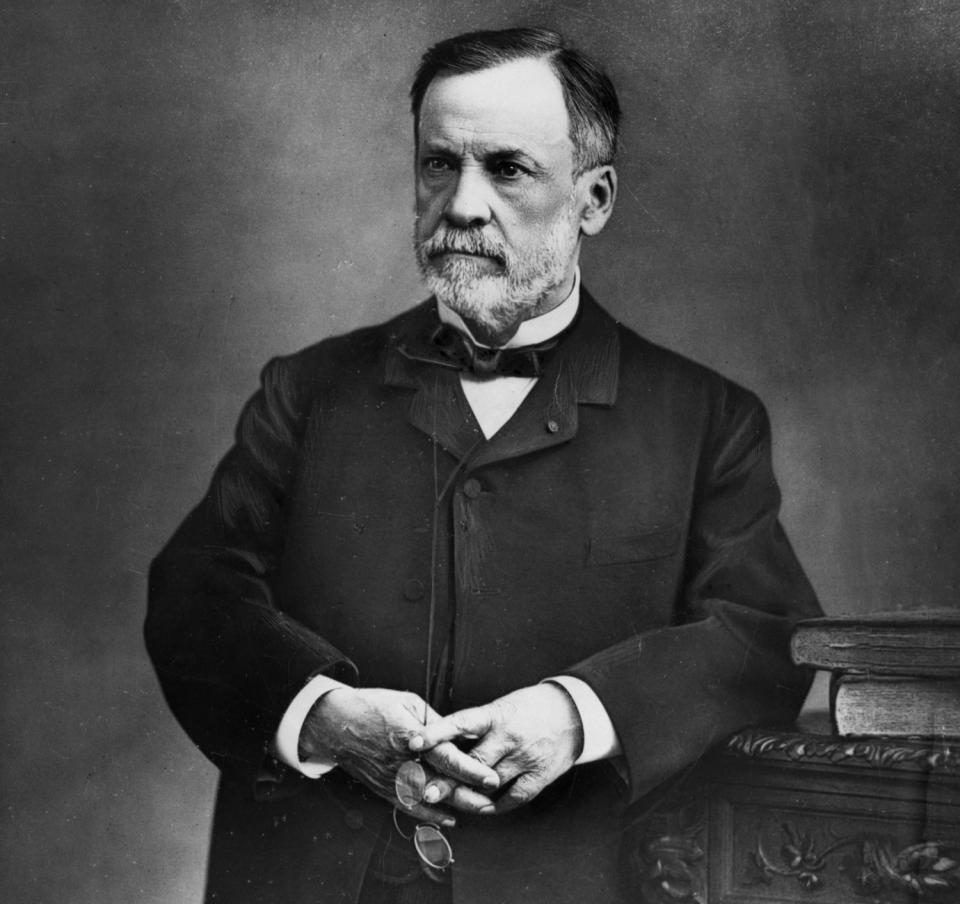You cured a deadly disease — and now you're afflicted by fame

After his discovery of a polio vaccine made Jonas Salk a household name in the 1950s, broadcaster Edward R. Murrow summed up the price of fame. "Young man," he told Salk, "a great tragedy has just befallen you. You have just lost your anonymity."
Salk quickly learned what Murrow meant.
"He couldn't go to a restaurant without people coming up to him, and it was terrible for his family," said Charlotte DeCroes Jacobs, whose biography "Jonas Salk: A Life" explores the consequences of the scientist's celebrity. "And the dark side: con artists, obsessives, stalkers. But the worst part was his colleagues — he said, 'I am no longer one of them.'"
As the global coronavirus death toll surges past 300,000, more than 125 groups are racing to develop vaccines and other treatments. Many in the medical community predict an effective vaccine will be available in the next few years.
The person or people who create the first vaccine to halt the COVID-19 pandemic could spark the sort of fascination and adoration reserved for a musician, athlete or actor. If so, there are lessons to be learned from the fate of Salk and a handful of scientists like him.
"I think the first vaccine to cross the line, I will feel sorry for the people involved," said Gary Kobinger, who is heading a team of 22 immunologists and virologists working at Laval University in Canada to find a vaccine. "Because they will be under tremendous pressure and scrutiny."

Kobinger, director of the university's Research Centre on Infectious Diseases, knows what it's like to blaze this sort of trail: he was a lead developer of the Ebola vaccine that won FDA approval last year. He has worked to ensure the accomplishment wouldn't dramatically alter his life — "my days have never changed" — but the novel coronavirus is on another level.
For this reason, the fact that Kobinger doesn't expect to be first to the market with a coronavirus vaccine is a good thing, he said. Not that the urgency isn't there. "This could be the most important contribution I make in my life — that's how I see it now," he said.
Some infectious disease experts and medical historians doubted that the first coronavirus vaccine would mint a modern-day Salk or Louis Pasteur, who developed the rabies vaccine in the late 1800s.
"No single individual has in recent times made a vaccine," said Dr. Harry Greenberg, a Stanford University professor who has helped create several vaccines, including one for influenza. "It is a team sport."
It was in Salk's day, too. But for several reasons, the discovery became known as the "Salk vaccine."
Perhaps most important, he understood the power of the media, which fashioned him into a star.
I hope they take some warning out of Salk’s experience. I think there is a big downside.
Charlotte DeCroes Jacobs
The public has always craved a hero. Dr. Anthony Fauci, the central figure in the U.S. response to the COVID-19 crisis, has become a sensation for his earnest advisories and steady appearances at news conferences alongside President Trump.
The 79-year-old immunologist has even bewitched 25,000-plus fans who signed a petition to make him People's "Sexiest Man Alive." And days after he said in an interview that he wouldn't mind being portrayed on "Saturday Night Live" by Brad Pitt, the Oscar winner did just that.
But it's a safe bet Fauci's star would be eclipsed by the creator of a successful COVID-19 vaccine.
"Even if it is a team, [the media] may pluck the person who will be a hero out of it," Jacobs said. "I hope they take some warning out of Salk's experience. I think there is a big downside."
In 1948, Salk, then a professor at the University of Pittsburgh School of Medicine, began studying polio in a project funded by the National Foundation for Infantile Paralysis, which later became known as the March of Dimes.

An infectious disease that affects mostly children and can result in paralysis, polio had been a terrifying affliction in the early 20th century. Salk and members of his lab at the university produced an experimental vaccine in 1952.
After three years, and a study involving 1.8 million children, the success of the vaccine was announced to the world. Salk, then in his early 40s, became "the icon for the polio vaccine," Jacobs said.
In interviews and other appearances, Salk often tried to acknowledge the work of his colleagues, Jacobs said, but it was easier for the press to sell a simpler narrative — and his peers held it against him.
"The newspapers just grabbed on to Salk — he was the story," she said. "So no matter how much he tried, it looked like he was telling the press, 'Aren't I great?' "
Salk's group hadn't been the only one working on a vaccine. An effort led by Albert Sabin, a medical researcher at the University of Cincinnati College of Medicine, also produced a vaccine, which later became the main one deployed in the U.S. for decades. But Salk is the name that's remembered.
That point is not lost on Kobinger, who noted that the first vaccine isn't always the best.
"Let's say the first [coronavirus] vaccine is licensed in December 2020 — there will be a second one in January and a third in March," he said. "Is the first more important than second or third? The second or third could be cheaper, more effective, stable and safer."
Salk went on to found the nonprofit Salk Institute for Biological Studies in La Jolla, Calif., in 1960. Its creation marked a high point in Salk's post-vaccine career. But there were plenty of lows.
His fame had a devastating effect on his marriage to Donna Lindsay. "She could not accommodate the celebrity," Jacobs said. "Suddenly she was supposed to smile and dress up and couldn't do it."
Two years after their divorce, Salk married Françoise Gilot in 1970. A French painter, she was Pablo Picasso's former mistress, and someone who "wouldn't have looked twice" at Salk if not for his fame, Jacobs said.
"One of his sons said he became Frenchified; he changed his look, he capped his teeth," Jacobs said. "But something was missing. He was a very lonely person and he was continually looking for something."
What Salk may have been looking for, at least in part, was his next great medical discovery. It never came. "He didn't want to rest on his laurels," Jacobs said. "He wanted to cure a disease and he was afraid he would never be able to accomplish anything else."

Salk tried to develop an AIDS vaccine, but it evaded him and he died in 1995. His unorthodox approach — a "therapeutic vaccine" meant to help immune response in those already infected — had led to disapproval and even snickering in the medical community.
"I see him putting on his armor and getting onto his gray steed and galloping into the AIDS arena — and a lot of the young scientists are saying, 'Who the heck is that? What is he doing here?'" Jacobs said.
These days, virologists and others in the field stress that they work as parts of teams. Greenberg, who led the laboratory research that was tapped to create the first vaccine for rotavirus — a potentially deadly diarrhoeal disease affecting infants and young kids — had this to say about his effort: "In no way am I the discoverer of a vaccine."
Greenberg was willing to explain what it felt like to work on vaccines that saved lives. But the urge to downplay the accomplishments was apparent.

"I have complex feelings about it," Greenberg said. "I am proud of myself. Obviously, I have some intelligence and I worked hard, but to be in the right place at the right time is more luck than anything else."
UC Irvine professor Dr. Alan Barbour, who with colleagues invented a Lyme disease vaccine, seems to harbor even more complicated feelings: "I was much more excited about finding the cause of the disease than the vaccine. I was wary of what would happen."
There was good reason for his concern. Released in 1998, GlaxoSmithKline's LYMErix was effective at preventing Lyme disease infection but hit the market amid the growing anti-vaccination movement. A story published in a scientific journal led some in the medical community to believe certain people could develop autoimmune arthritis after receiving it.
The Food and Drug Administration examined the arthritis claims and didn't find a connection between the vaccine and the ailment, Vox has reported. Four years into the drug's existence, 1.4 million doses had been handed out, but only 59 reports of arthritis were made to the federal agency's Vaccine Adverse Events Reporting System, Vox reported.
Still, the damage had been done and the manufacturer withdrew the drug in 2002. "We are proud about our achievements — all I can say is it can be a mixed bag," Barbour said.
Barbour worried that the first coronavirus vaccine could face similar skepticism from doubters and others — perhaps on a much larger scale. He said that whoever develops the initial vaccine is "going to have to deal with people who think this is a hoax, or that a vaccine is going to make matters worse."
Should a star virologist emerge in the COVID-19 fight, he or she might look to Pasteur as example of an esteemed medical mind who channeled stardom into new success. After his rabies vaccine made him an international hero, he crafted a humble persona for the public that helped him promote "medical science as a boon for humanity," said USC history professor Aro Velmet.
"He was a very savvy PR guy," said Velmet, whose specialties include technology and medicine.
Hoping to create a sprawling research institute, Pasteur wrote to prominent people, such as Czar Alexander III of Russia, saying, "the person who cured rabies wants to cure other diseases," Velmet said.
It worked. The Pasteur Institute was founded in 1887 — eight years before he died. It became the largest nonprofit medical research facility in the world.
Pasteur was a hero, and so was Salk. But these singular figures aren't the norm.
And yet the allure of these seminal individuals seems likely to be heightened in the age of coronavirus.
"The media's desire to tell these heroic stories of virus hunters," said Velmet, "has been around since the very first vaccine was invented."

